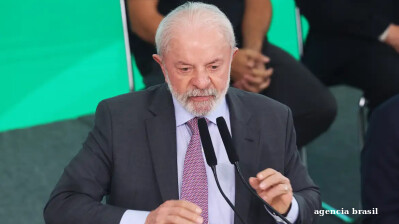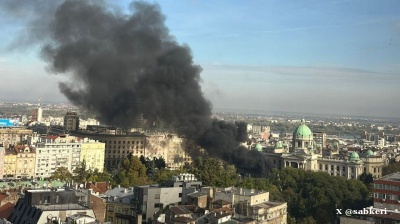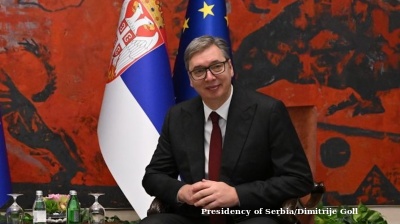Ukraine appears to have averted a disastrous default on its debt and has secured a last-minute “comprehensive restructuring” of its external public commercial debt, Finance Minister Serhii Marchenko announced on July 22.
"Today we reached an agreement in principle with the committee of Eurobond holders," Prime Minister Denys Shmyhal said, adding the deal includes haircuts for the investors that will save $11.4bn over the next three years and $22.75bn by 2033.
Under the deal some of the world’s biggest investors, including BlackRock, Amundi and Amia Capital, will write off a large part of $23.4bn by exchanging their bonds for new ones that will have maturities of as much as 12 years, Politico reports.
And the new bonds will kick the payments down the road, so there is nothing to pay this year and modest payments up until 2025, buying the government some time and allowing it to deploy all its limited resources for military spending.
A three-year debt restructuring deal that was cut soon after the war with Russia started had been due to expire on August 1, which would have meant the Ministry of Finance (MinFin) having to pay off two years of accumulated coupon payments in one go. Talks with a committee of European bondholders had been going slowly, but the new deal allows payments to be delayed again that would have thrown government finances this year into chaos.
"After months of negotiations and hard work with private creditors, the IMF and official creditors, we have reached an agreement with the committee of European bondholders on a comprehensive restructuring of our external public debt," Marchenko stated.
The deal may have been catalysed by a bill passed by the Rada on July 18 that allows the government to suspend payments on external public debt until October 1, 2024, Ekonomichna Pravda reported last week just before this week’s negotiations began.
Previously MinFin was asking for a 60% haircut, but the bondholders offered a 22% reduction. MinFin then compromised, dropping its offer to a 40% haircut, but the talks still stalled.
The compromise solution was bondholders agreed to, "a nominal upfront haircut of 37% which will cause the stock of debt to be reduced by $8.5bn. However, calculated in net present value (NPV) terms, the haircut is around 60%," a spokesperson for the Ministry of Finance explained told bne IntelliNews.
The Ministry also confirmed that in way of compensation, the agreement also includes the issue of GDP-linked warrants that will reward investors if the economy bounces back should peace return that will recoup some or more than all of the value they give up from the current haircut.
"If Ukraine’s economy performs very well (i.e. nearly pre-war levels or outperforming the IMF’s projections for GDP growth by more than 7.5%), then bondholders could have a 12% additional nominal amount of bonds. In practice, this would happen through increased principal amount on Bond B 2035 and 2036 series," the spokesperson said.
While the details are not clear, it appears that the new deal includes GDP-linked warrants as a sweetener. These link payouts to GDP growth after a certain period has passed and can be extremely lucrative for investors if the economy bounces back strongly following the end of hostilities. They were used as a sweetener in the previous 2015 bond restructuring deal following the EuroMaidan revolution that caused an economic crisis. Politico reports that the haircut bondholders will take could be reduced to 37% thanks to the GDP warrants, which kick in in 2028.
Bondholders will have to surrender their existing bonds in return for two new series of paper, Bond A and Bond B, and coupon payments will total a mere $200mn in 2024 and 2025, with the first tranche only due in February 2025. Prior to this restructuring Ukraine would have been on the hook for $5bn of payments over the next 12 months.
"The new bond structure will see a 90% reduction in debt payments due over the course of the IMF programme period (equal to savings of $11.4bn) and a 75% reduction until 2033 (savings of $22.75bn)," according to MinFin.
Ukraine will only have to pay interest until 2029, when it will have to start amortising Bond A. Amortisation payments for Bond B start a year later. Both series run until 2036, and the repayments step up, the longer they run, Politico reports.
Marchenko stressed that this financial relief will allow Ukraine to allocate more resources towards defence and social spending.
This restructuring is expected to pave the way for Ukraine’s early return to the international capital markets, once the security situation stabilises, facilitating the country’s rapid recovery and reconstruction efforts.
A default would have complicated Ukraine’s return to the market at a time when it will need to raise tens of billions of dollars to pay for the reconstruction of the country.
It would have also complicated Ukraine’s deal with the IMF, which insists on responsible treatment of creditors. The IMF Board of Directors has just completed the fourth review of the Extended Fund Facility (EFF) for Ukraine, approving the disbursement of another $2.2bn to support Ukraine's budget, the Fund announced in a statement on June 28.
The IMF is another major source of funds for Ukraine, which has fulfilled more than half of the IMF's requirements and received $10.2bn from the fund since the beginning of the war.
Concurrently, some holders of Ukraine 2015 vintage GDP warrants have started to form a group to represent their interests in the sovereign debt restructuring, which were not included in the current talks.
The deal is still only a deal in principle and needs to be ratified by two-thirds of bondholders to enter into legal force. Ukraine has assured investors of its commitment to finalising the restructuring before the moratorium on repayments concludes on August 1.
Desperate for money
The government is becoming increasingly desperate for money, as international donors will not provide enough support this year to cover the planned expenditure, 60% of which is earmarked for the military.
Ukraine has passed a budget with a record $43bn deficit, but international donors have promised a total of $38bn this year. The government has said that with some cuts it will muddle through, but the bond payments, if they had come due in August, would have made the job of squaring the circle much more difficult.
Currently Ukraine is almost entirely dependent on international financing to cover its budgetary needs, which account for some two thirds of funding. Ukraine raises another third from issuing Ukraine’s Ministry of Finance federal treasuring bonds (OVDPs), but non-resident investors only count for about 2% of the outstanding bills.
The majority of investors into the domestic debt are local banks, but as detailed in a recent bne IntelliNews article, Ukraine lacks men, money and materiel and the local banking liquidity is largely tapped out as banks reach their prudential bond investment limits.
The OVDPs pay a fantastic c19% yield, so this is a very expensive form of credit for the government, but MinFin imposed a one-off 50% tax on the banking sector at the end of 2023, recouping much of the money it had given banks making these investments. This year the tax has been lowered to a more manageable, but still high, 25% of profits.
Nevertheless, Ukraine lacks UAH500bn ($12bn) to finance its planned expenditures this year, even with an aggregate 170% increase in taxes raised from the financial sector.
At the same time, the government plans to increase spending by the same amount, with the bulk of this being directed to military spending. In order to fund such expenditure, the government intends to take the unpopular step of raising taxes, focusing on a 2-3% for VAT and raising the war tax from 1% to 5%. However, according to the government, this will only raise an additional $4.5bn this year, if the new rules are implemented in September after the Rada’s summer recess is over.
The fall-back plan is to simply print the missing money, as the government was forced to do in the first six months of the war, and risk spiralling inflation.
The lack of financing is one of the factors that will go into the mix towards the end of the year, when Ukrainian President Volodymyr Zelenskiy will have to decide whether Ukraine can continue the war or will have start ceasefire talks with Russia. The lack of sufficient arms and ammo by Ukraine’s Western partners is another factor. Zelenskiy complained last week that it’s been 18 months and the badly needed F-16s have yet to arrive. The fact that Russia has destroyed half of Ukraine generating capacity, ahead of what will be a long and dark winter, is another factor.
Nevertheless, Ukraine's government has approved changes to the state budget that include a proposed spending increase of UAH500.3bn, of which UAH495.3bn will be directed to the security sector and defence.
One of the possible sources of funding is a $50bn loan agreed by the G7 countries; however, the disbursement of this loan has become bogged down in wrangling amongst the members of the G7 and other participating countries, which cannot agree on how to share the burden of this loan. According to recent reports, this money is unlikely to be available until the end of this year at the earliest. The European Commission plans "very soon" to propose a $50bn loan to support Ukraine and finish all the necessary legislative work by the end of the year, says the European Commissioner for Economy, Paolo Gentiloni.
Following the agreement by the G7 summit in June to the $50bn loan backed by proceeds from frozen Russian assets, the US and the EU are expected to take on $20bn each, and Japan, Britain and Canada will share another $10bn. Japan is considering a $3.3bn loan and France, Germany, and Italy have not yet joined the lending programme, as the European Union already has a similar support plan.
Must of the money from other pledges cannot be used for military spending. Most of the military spending that is part of the US $61bn support package passed in the summer will be spent with US arms manufacturers to replenish the US’ own stockpile as well as manufacture arms for Ukraine in the US. Only a fraction of the money will be sent to Ukraine as cash that can be used for military spending, where a large part of Ukraine’s planned spending will simply go to pay soldiers’ salaries.
Likewise, the EU’s four-year €50bn support package, approved at the start of this year, is exclusively intended for non-military purposes.
News

Brazil's Lula announces fourth presidential run at 80
Brazilian President Luiz Inácio Lula da Silva has announced he will seek re-election in October 2026, confirming his candidacy during a state visit to Indonesia on October 23.

Serbian president blames opposition for “terrorist attack” outside parliament
President Vucic blamed opposition groups for what he described as a “terrorist act” outside the National Assembly in Belgrade, after a 70-year-old man opened fire on a camp of government supporters and set fire to one of their tents.

IOC sanctions Indonesia over Israel visa ban
The International Olympic Committee has announced that international sports federations will be advised not to hold competitions or meetings in Indonesia after the country barred Israeli athletes from entering.

Serbian president accuses EU of backing “colour revolution” after European Parliament adopts harsh new resolution
MEPs back the toughest rebuke yet from Brussels towards Serbia in over a decade of EU candidacy.




